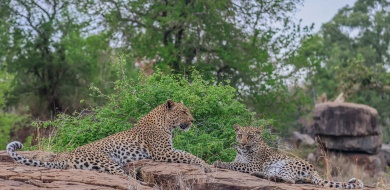A Week in the Bush Vol. 570
on Nov 05, 2025This tiny hyena cub enjoyed the morning sun, snuggling up next to its mother in the safety of their den. Hyenas typically give birth and raise their cubs in secure den sites - like old burrows, but especially in empty termite mounds where another animal would have burrowed down sometime before. This denning behaviour puts them at a great advantage as cubs can go underground into small tunnels and cavities to escape danger, and mothers can leave their cubs for extended periods without having to worry too much about their safety.

Spending time at waterholes is especially rewarding this time of year, particularly for bird enthusiasts. From nest building to fishing, there’s constant bird activity throughout the day. This Hamerkop was busy hunting along the banks of the waterhole, searching for fish or frogs, when a group of baboons disturbed it, prompting the bird to leave the area.


On our morning safari we noticed vultures circling ominously above, some even descending into a thicket. Curious, we followed the activity which led us to trees covered in White-backed and Hooded vultures. Venturing further in, we could hear hyenas scuffling, and bones being crushed in their strong jaws. A clan of roughly twenty hyenas were finishing off a giraffe carcass while the vultures squeezed in between them, opportunistically pulling bits and pieces out from beneath the ravenous hyenas. All the scavengers worked tirelessly to dismember the carcass - the hyenas dislodged joints and bones and the vultures stripped away all of the membranes and connective tissues that the hyenas’ teeth were too large to reach. An amazing spectacle of both fierce competition and remarkable coexistence.
We came across this stunning waterbuck bull, grazing and occasionally posing in the gentle warmth of the morning sun. Predominantly grazers, waterbuck consume types of coarse grass seldom eaten by other animals - occasionally browsing leaves from certain trees and bushes. They feed in the mornings and at night, resting and ruminating throughout the remainder of the days.

This Grey-headed Kingfisher perches quietly on a branch, its striking blue wings glowing in the light. Unlike many other kingfishers, this species hunts mostly on land, swooping down to catch insects and small reptiles rather than fish. Often seen during the warmer months, its sharp call and vibrant colours bring a splash of life to the bushveld.

Far in the distance, we spotted vultures lifting off from the ground - a sure sign that a carcass, and perhaps a larger predator, might still be nearby. As we drew closer, jackals and hyenas came into view, racing toward the commotion. There, amidst the chaos, we found them feeding on the remains of a young buffalo - the aftermath of a kill made by the four N’waswishaka male lions the previous night.


An adult Bateleur eagle perches confidently on a branch beneath the cloudy morning sky, its striking black, chestnut, and grey plumage standing out against the muted background. Known for their short tails and effortless gliding flight, these eagles are skilled scavengers and hunters, often the first to spot carcasses from great distances - a vital role in keeping the ecosystem clean and balanced.

A magnificent nyala bull stands proudly, showing off his striking features - the rich chocolate-brown coat, spiral horns, and long white fringe along his back. This impressive display isn't just for show, it's a visual sign of dominance used to intimidate rivals and attract females, a perfect example of how beauty and behaviour intertwine in nature’s design.

A hippo carcass, the result of a fierce territorial battle, has drawn in numerous vultures and several hyenas. This dramatic scene highlights nature's cycle of life and death - where nothing goes to waste. The scavengers play a crucial role in cleaning the environment, recycling nutrients back into the ecosystem, and ensuring that the bush remain healthy and balanced.




Early one morning, we found five individuals from the Southern Pride feeding on a buffalo, their faces stained with the evidence of a successful hunt. Nearby, the sub-adult males asserted their growing confidence, charging at opportunistic hyenas attempting to sneak for scarps. Scenes like this highlight the power dynamics of the bush - a constant struggle between predator and scavenger, strength and survival.


We found one of the young N’waswishaka male lions as he was striding purposefully through the bush, his deep, soft calls echoing as he followed the scent trail of his three brothers. Lions rely heavily on scent and vocal communication to maintain contact within their pride or coalition, and his determined walk shows the strong social bonds that unite these powerful cats.


While driving across a vast open plain, we came across a pair of beautiful lions lying in the open, waiting for the morning sun to break through the clouds. It was clear they were in the midst of a mating period - the male kept a close watch over the female and their surroundings, ensuring she was protected from any unwanted visitors. Only time will tell how the lion dynamics in the southern parts of our reserve will unfold over the coming months, especially with the increasing number of young males moving through the area.


We noticed a high presence of vultures flying to the ground and sitting in trees all around a thicket. To minimise the damage on the bush, the ranger and tracker teams set out on foot to investigate. Following the vultures we came across the 2 dominant Gijima male lions feeding on a buffalo cow.
One of the males was already resting under a tree, hiding from the extreme heat of the early morning sun, while the other fed on the buffalo. With the amount of meat still left on the carcass it was clear that this cow was possibly pregnant and is what the other male had fed on, leaving the rest of the adult buffalo for his brother.




The young cubs from the Styx Pride were the first to wake up as the afternoon cooled down. They got up and moved from female to female, rubbing their heads against theirs and attempting to suckle from them.
The youngest of the Styx cubs are now around 6 months old, meaning that they will be weaned from suckling from their mothers and soon start feeding on solid food, either by feeding from kills dragged to the cubs by the adults, or by being brought to the kill site by one of the adults.
With the cubs moving from one female to another, often attempting to suckle from any lactating female, they will also receive communal care and grooming from all the pride members, to ensure the strength and survival of the pride.



This solitary male cheetah often moves through our reserve, enjoying his vantage points from large termite mounds in the many open plains that we have scattered across the reserve.
Being a nomadic male, he will cover large areas, scent marking and defending the territory that he has established, in search of potential females to mate with. Being solitary does bring more challenges to holding a territory, than what cheetah coalitions might have.




The Golonyi female leopard moves with purpose through the bush, calling softly as she searches for her sub-adult male. Once he appears, she leads him through the thickets towards a hidden spot where she likely stashed a recent kill. This behaviour shows the strong maternal bond and teaching moment - guiding her young to feed while ensuring the safety of both her offspring and the precious meal.






The team set out on the morning safari, eager to find signs of the male leopard that had moved through the reserve the previous afternoon. After an extensive search following tracks and clues, the bush suddenly came alive - the sharp alarm calls of impala and bushbuck echoed through the trees, a clear signal that a predator was close.
Following the sounds, we soon spotted the male leopard moving purposefully toward a large tree. In a flash, he leapt up the trunk, disappearing into the branches. Only his distinctive straight tail with the white tip remained visible - the unmistakable signature of the Nottins male leopard. There he settled, finding refuge from the heat that had been gripping the area.
As the impala gradually relaxed and began to graze once more, the leopard lifted his head, eyes fixed on the herd below, watching with silent, focused intensity.


Vultures had alerted us to a potential kill. By then, the morning sun was high, and the temperatures were climbing - perfect conditions for thermal winds, which these birds use to effortlessly glide across the sky in search of food. Following their path, we discovered the zebra. How it had died remained unclear, but it was evident that no predator was involved; there were no signs of struggle, and no big cats were around (yet) to feed on it.
The vultures descended excitedly, tearing open the carcass, soon joined by a hyena investigating the scene. Each scavenger scrambled for a spot at the table, a chaotic yet fascinating display. The highlight, however, was a singular Cape Vulture towering over its smaller cousins. These magnificent birds are rarely seen in the area, as they typically nest on cliffs in mountainous regions far beyond Sabi Sand Game Reserve and Kruger National Park. Witnessing one here was truly remarkable.
Later, we came across the Mawelawela male leopard feeding on the carcass. Opportunistic by nature, leopards will readily scavenge when the chance arises, conserving valuable energy instead of hunting. This powerful predator uses its strength and stealth to guard such a meal, often dragging it into thicker cover to feed safely, away from potential scavengers.






Until next time…

Blog by Wendy Claase
Images by Jan Nel, Jana du Plessis, Ronald Mutero, Ruan Mey and Viviane Ladner
Video by Viviane Ladner







